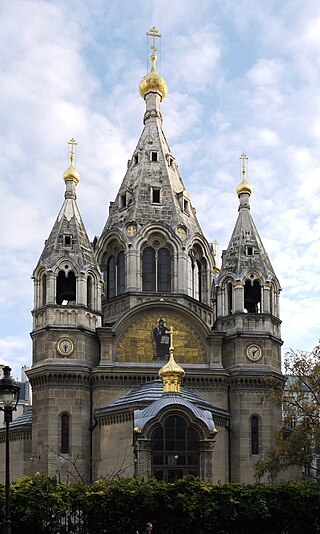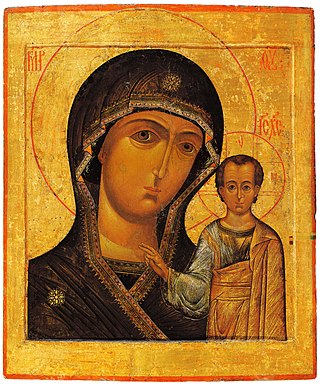This article needs additional citations for verification .(February 2017) |
Eastern Orthodoxy in Taiwan represents Christians in Taiwan who are adherents of the Eastern Orthodox Church. [1]
This article needs additional citations for verification .(February 2017) |
Eastern Orthodoxy in Taiwan represents Christians in Taiwan who are adherents of the Eastern Orthodox Church. [1]
Eastern Orthodoxy arrived in Taiwan around 1895, the year the Qing Dynasty ceded the island to Japan. These first Orthodox believers were Japanese immigrants, who almost immediately began petitioning St. Nicholas (Kasatskin), Archbishop of Japan to send them a priest. In 1901, a Tokyo synod created the Christ the Savior Parish in Taiwan. Its first priest was Fr. Simeon (Okava or Yukava—spellings differ), followed (in 1911) by a Fr. Titus (Kariyama). Records indicate a Taiwan-based Orthodox population of 15 or 17 (in 1900), 29 (in 1901), and 44 (in 1903). The activity of the community was interrupted by the 1912 death of St. Nicholas of Japan, and largely ceased with the end of Japanese rule in 1945.
Sayama Dayroku, later Archbishop Nicholas of Ramensky (near Moscow), was born 1914 in Taihoku (Taipei). [2] [3]
In 1949, some 5000 Russians arrived from China (e.g. Shanghai, Harbin, Xinjiang) in the wake of the Chinese Civil War, and began gathering in Taipei's Cafe Astoria. Mention is made of a Korean War-era funeral led by Bishop (later Archbishop) John (Shahovskoy) of San Francisco, then a U.S. army chaplain en route from Korea to the USA. Archbishop Ireney (Bekish) of Tokyo (later New York) made annual visits to Taipei between 1957 and 1959, celebrating divine liturgy in a private home, under the name of the Church of the Forerunner. In 1960 he ceded these duties to an American military chaplain, Fr. Nikolay Kirilyuk. 1965 saw a visit by Metropolitan Vladimir (Sagosky) of Japan (later San Francisco), American military chaplain Archpriest Peter Zurnovich, and Fr. Kirill Arihara. The number of Orthodox faithful in Taiwan has been variously estimated at 50 (in 1960), 100 (in 1958), and 200 (in 1965). [4] [5] [6] The Russian community's most famous member, Chiang Ching-kuo's Belarusian-born wife Chiang Fang-liang (née Faina Ipat'evna Vakhreva), did not attend services (and may have nominally affiliated with her husband's Methodism).
Sources differ as to whether this predominantly Russian church had any contact with the earlier wave of Japanese-era believers. By the 1970s the church had again dwindled into inactivity, in part because of a canonical rule requiring the closure of any parish which goes more than fifty years without a resident priest.
But nevertheless, the Taiwanese Orthodox Church was re-established by a Greek hieromonk, Fr. Jonah (Mourtos) of Osiou Gregoriou monastery (Mount Athos) in the year of 2001 AD under the auspices of the Metropolitan of South Asia under the Ecumenical Patriarchate of Constantinople in Istanbul. The attendants are mainly Russian and other Slavic people but gradually, more and more Taiwanese locals are coming to Orthodoxy. In 2012 the Russian Orthodox Church reactivated the parish of Christ the Savior in Taipei under the leadership of a priest from Canada. The trilingual parish celebrates the services in a mixture of Chinese, English, and Slavonic.
The Holy and Sacred Synod of Constantinople founded also the new Orthodox Metropolitanate of Hong Kong and South East Asia in November 1996, with jurisdiction over: Hong Kong, Macao, China, Taiwan, Mongolia, Philippines, Vietnam, Cambodia, Laos, Thailand, Myanmar, and also Singapore, Indonesia, Malaysia, Brunei, East Timor, Maldives, Sri Lanka, Bangladesh, India, Nepal, Pakistan and Afghanistan. [7] [8]

The Russian Orthodox Church, alternatively legally known as the Moscow Patriarchate, is an autocephalous Eastern Orthodox Christian church. It has 194 dioceses inside Russia. The primate of the ROC is the Patriarch of Moscow and all Rus'.

The Chinese Orthodox Church is an autonomous Eastern Orthodox church in China. It was granted autonomy by its mother church, the Russian Orthodox Church, in 1957.
The Latvian Orthodox Church is an Eastern Orthodox church in Latvia, part of the wider Eastern Orthodoxy community. The primate of the church carries the title of Metropolitan of Riga and all Latvia. This position has been occupied since October 27, 1990, by metropolitan Aleksandrs Kudrjašovs.

The Ukrainian Orthodox Church (UOC), commonly referred to by the exonym Ukrainian Orthodox Church of the Moscow Patriarchate (UOC-MP), is an Eastern Orthodox church in Ukraine.
Eastern Orthodoxy in France is the totality of all Eastern Orthodox churches in France.

The Archdiocese of Russian Orthodox Churches in Western Europe is an archdiocese of the Russian Orthodox Church with special status, headquartered in Paris. It comprises various Russian Orthodox parishes located throughout Western Europe.
The timeline of Eastern Orthodoxy in North America represents a timeline of the historical development of religious communities, institutions and organizations of Eastern Orthodox Christianity in North America.

The Metropolis of Korea is an Eastern Orthodox diocese under the jurisdiction of the Ecumenical Patriarchate of Constantinople in Korea.
The Exarchate of the Philippines is an exarchate or sub-diocesan entity of the Eastern Orthodox Metropolis of Hong Kong and Southeast Asia that is located in the Philippines. The metropolis is one of four metropolises in Asia that are under the jurisdiction of the Ecumenical Patriarchate of Constantinople. The exarchate has five parishes and three chapels in the country.
The Metropolis of Hong Kong and Southeast Asia is a metropolis or archeparchy of the Ecumenical Patriarchate of Constantinople in the Eastern Orthodox Church. It is equivalent to an archdiocese in the Catholic Church. It is centred on the city of Hong Kong and has jurisdiction over Eastern Orthodox Christians in Hong Kong, Macao, China, Taiwan, Mongolia, the Philippines, Vietnam, Cambodia, Laos, Thailand and Myanmar. It was established in November 1996 by the Holy Great Synod of Constantinople. The incumbent metropolitan is Nektarios Tsilis.

Eastern Orthodoxy in Vietnam is represented by 3 parishes of the Russian Orthodox Church: one in Vung Tau, named after the icon of Our Lady of Kazan, where there are many Russian-speaking employees of the Russian-Vietnamese joint venture "Vietsovpetro", and also parish of Xenia of Saint Petersburg in Hanoi and parish of Protection of Our Most Holy Lady Theotokos and Ever-Virgin Mary in Ho Chi Minh City.
George of Evdokias was an Eastern Orthodox archbishop who led the Patriarchal Exarchate for Orthodox Parishes of Russian Tradition in Western Europe from 1981 to 1993, under the jurisdiction of the Ecumenical Patriarchate of Constantinople.
Eastern Orthodoxy in Hungary refers to communities, institutions and organizations of the Eastern Orthodox Christianity in Hungary. Historically, Eastern Orthodoxy was an important denomination in the medieval and early modern Kingdom of Hungary. In modern times, Eastern Orthodoxy is mainly the religion of some ethnic minorities. In the 2001 national census, only 15,928 persons declared themselves Orthodox Christians. Estimates in 2020 suggested that 1.54% of the population was Orthodox.
Eastern Orthodoxy in Estonia is practiced by 16.5% of the population, making it the most identified religion and Christian denomination in this majority-secular state after surpassing Lutheran Christianity with 9.1% for first time in country's modern history. Eastern Orthodoxy, or more specifically Eastern Orthodox Christianity, is mostly practiced within Estonia's Russian ethnic minority and minority within native population. According to the 2000 Estonian census, 72.9% of those who identified as Orthodox Christians were of Russian descent.

Christianity in Taiwan constituted 3.9% of the population, according to the census of 2005; Christians on the island included approximately 600,000 Protestants, 300,000 Catholics and a small number of members of the Church of Jesus Christ of Latter-day Saints.
The Indonesian Orthodox Church is a diocese which has been under the jurisdiction of the Church of the Genuine Orthodox Christians of Greece since 2019. The theology and praxis of the church is essentially the same as any other Eastern Orthodox Church, though they are not in communion with the larger body of Eastern Orthodox Christians. The legal entity of the Indonesian Orthodox Church was founded and is still managed in day-to-day affairs by Daniel Bambang Dwi Byantoro, and its history is in many ways inseparable from his own.
The Metropolis of Singapore and South Asia is a diocese of the Ecumenical Patriarchate of Constantinople in the Eastern Orthodox Church. It is centered in Singapore and has jurisdiction over Eastern Orthodox Christians in the countries of Singapore, Indonesia, Malaysia, Brunei, East Timor, the Maldives, Sri Lanka, Bangladesh, India, Nepal, Bhutan, Pakistan and Afghanistan. It was founded in January 2008 by the Holy Synod of the Ecumenical Patriarchate of Constantinople.

In 1996 a schism between Moscow and Constantinople occurred; this schism began on 23 February 1996, when the Russian Orthodox Church severed full communion with the Ecumenical Patriarchate of Constantinople, and ended on 16 May 1996 when the Russian Orthodox Church and the Ecumenical Patriarchate reached an agreement.

The Diocese of the Philippines and Vietnam is a diocese of the Patriarchate of Moscow created on 26 February 2019, directly under the Patriarchal Exarchate in Southeast Asia (PESEA).
The Patriarchal Exarchate in South-East Asia is an exarchate created by the Russian Orthodox Church (ROC) on 28 December 2018.